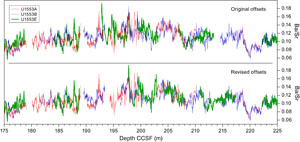Röhl, U., Thomas, D.J., Childress, L.B., and the Expedition 378 Scientists
Proceedings of the International Ocean Discovery Program Volume 378
publications.iodp.org
https://doi.org/10.14379/iodp.proc.378.201.2022
Data report: splice adjustment for Site U15531
A.J. Drury,2 T. Westerhold,3 R.H. Wilkens,4 and U. Röhl3
1 Drury, A.J., Westerhold, T., Wilkens, R.H., and Röhl, U., 2022. Data report: splice adjustment for Site U1553. In Röhl, U., Thomas, D.J., Childress, L.B., and the Expedition 378 Scientists. South Pacific Paleogene Climate. Proceedings of the International Ocean Discovery Program, 378: College Station, TX (International Ocean Discovery Program). https://doi.org/
2 Department of Earth Sciences, University College London, United Kingdom.
3 MARUM—Center for Marine Environmental Sciences, University of Bremen, Germany.
4 School of Ocean and Earth Science and Technology, University of Hawaii, USA. rwilkens@hawaii.edu
Abstract
Postcruise examination of the data splice for International Ocean Discovery Program Expedition 378 Site U1553, in light of new X-ray fluorescence data, revealed three cores from Hole U1553E that were misaligned. These cores have been shifted to fill in some gaps in the original splice.
1. Introduction
Postcruise examination of the data splice for International Ocean Discovery Program Expedition 378 Site U1553, in light of new X-ray fluorescence data, revealed three cores from Hole U1553E that were misaligned. These cores have been shifted to fill in some gaps in the original splice (Röhl et al., 2022) where Hole U1553B cores had originally been appended.
2. Results
The offset for Core 378-U1553E-21X was shifted deeper by 4.63 m, Core 22X was shifted deeper by 4.75 m, and Core 23X was shifted deeper by 3.92 m. No other cores were shifted, so depths of samples taken from other cores need no adjustment. A comparison of the original splice to the revised splice is illustrated in Figure F1 and overlays of the original and shifted X-ray fluorescence data are presented in Figure F2. The original offsets of the three cores of Hole U1553E made their inclusion in the splice problematic. Shifting the three cores allowed for a new splice to be constructed that fills some gaps in the original splice where Hole U1553B cores had been appended. These corrections create a more continuous splice in the latest Eocene around the Eocene–Oligocene transition.
Revised offsets are presented in Table T1, and revised splice intervals are presented in Table T2.
3. Acknowledgments
This research used samples and/or data provided by the International Ocean Discovery Program (IODP). Funding for this research was provided by the U.S. Science Support Program, IODP.
Reference
Röhl, U., Thomas, D.J., Childress, L.B., Anagnostou, E., Ausín, B., Borba Dias, B., Boscolo-Galazzo, F., Brzelinski, S., Dunlea, A.G., George, S.C., Haynes, L.L., Hendy, I.L., Jones, H.L., Khanolkar, S.S., Kitch, G.D., Lee, H., Raffi, I., Reis, A.J., Sheward, R.M., Sibert, E., Tanaka, E., Wilkens, R., Yasukawa, K., Yuan, W., Zhang, Q., Zhang, Y., Drury, A.J., and Hollis, C.J., 2022. Site U1553. In Röhl, U., Thomas, D.J., Childress, L.B., and the Expedition 378 Scientists, South Pacific Paleogene Climate. Proceedings of the International Ocean Discovery Program, 378: College Station, TX (International Ocean Discovery Program). https://doi.org/

